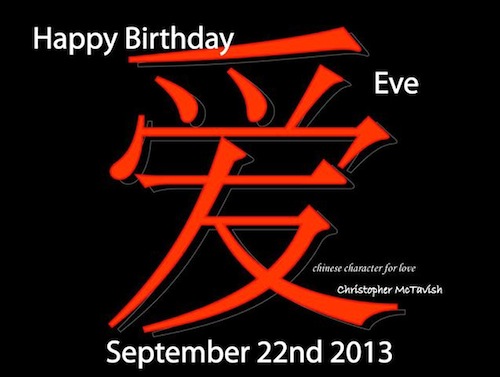The Gift of Kanji
As you may have noticed, Joy o' Kanji was on vacation last week. To celebrate my birthday, my husband, dogs, and I spent five blissful days near the white-sand beaches of Los Angeles, taking walks under palm trees and fantasizing about living in that paradise. (Those thoughts disappeared whenever we found ourselves stuck in traffic.)
I found lots of kanji to photograph, which made me even happier. So did the kanji gifts I received from some wonderful people in my life.
First off, Chris McTavish posted this image on my Facebook page:

How thoughtful he was to go to such lengths to create something so visually delectable! I also appreciated this gift on another level. I see this character all the time in tattoos and on T-shirts, but because it appears in a flash and then disappears as soon as the person passes, I've never had the chance to figure out why it makes me feel confused. Now I understand. This character is from China, not Japan. (Chris knows Japanese but specializes in Chinese.) In contrast to the Japanese 愛, the hanzi simplification is missing the heart (心). This bewilders Chris: "How can you have love without the heart?" Because the two characters have the same top and bottom, one can't notice the discrepancies without close attention. Chris has, in effect, made the world slow down for me, giving me clarity on this matter!
Another friend, Ulrike Narins, went way out of her way to create this lovely piece of calligraphy for me:

Any idea about the significance of her choices?! That's really hard, so I'll give you the same hint she provided me:
久 (ク: long time)
守 (シュ: to guard, protect, defend)
名 (な: name; distinguished, noted)
良 (イ: good)
富 (フ: wealth; to enrich; abundant)
Okay, but it's still hard! Why those kanji? What was she telling me? Think about it for a moment while I tell you about the third amazing gift.
This last one came from a friend with impeccable taste and boundless generosity. She gave me the most beautiful book I've probably ever owned. Here's the cover:

This collection of artwork is copyrighted, so I unfortunately can't show you the mesmerizing designs and vivid colors that soothe the eye and engage the mind. Nor can I find the words to describe the beauty of those pieces. Artist Makoto Fujimura says he is influenced by both nihonga (日本画, にほんが: Japanese-style paintings) and rimpa (琳派, りんぱ, where the first kanji is non-Joyo), though he notes that his work doesn't fall strictly into either category.
I found my way to his website and enjoyed a six-minute video that's partly in Japanese with English subtitles and partly in English. Unexpectedly, the video brought me back into the wonderful world of kanji! At 1:20, Fujimura enters a Japanese shop filled with the pigments that changed his life. That's nice, but what about the kanji on those pigment bottles?! There's the life-changing thing, if you ask me! The video includes a few kanji signs, so give it a look-see.
Okay, let's return to the calligraphy "quiz." Here, again, are the kanji in question:
久 (ク: long time)
守 (シュ: to guard, protect, defend)
名 (な: name; distinguished, noted)
良 (イ: good)
富 (フ: wealth; to enrich; abundant)
Collectively, they form my name, or one rendering of it: クシュナ•イフ!
As long as we're on the topic of birthdays (at least we were initially!) and aging (which I've deftly avoided discussing here and everywhere else!), I'll share some Japan-related and age-related things that I've encountered quite recently.
In the past, the Japanese considered people to be one year old at birth. On New Year's Day, everyone would become a year older, regardless of when their birthdays were. Here's the term for this system:
数え年 (かぞえどし) counting + years
By contrast, the current system goes by this name:
満年齢 (まんねんれい) full + years + age
As 満 (full) implies, 満年齢 refers to counting completed years.
But should we actually count the completed years? Maybe not! Here's what my proofreader told me: "My friend's father happened to be a vice-minister in the government in the 1990s. One day I told him, 'You always look young—much younger than your age.'"
Here's how the man replied:
「今は戦国時代じゃないんだよ。当時は人生50年と言ったがね。今は人生80年。今は、自分の歳に7掛けしたのが本当の自分の歳だよ。」
"This is not the age of the provincial wars. In those days people lived only 50 years. These days we have an average life expectancy of 80. So now the real age is the given age times 0.7."
今* (いま: now); 戦国時代 (せんごくじだい: Warring States period, approx. 1467–1568); 当時 (とうじ: at that time); 人生* (じんせい: (human) life (i.e., conception to death)); 年* (とし: years); 言う (いう: to say); 自分* (じぶん: oneself); 歳* (とし: age); 7掛け (なながけ: multiplying a number by 0.7); 本当 (ほんとう: real)
My proofreader comments, "I have decided to conform to his golden rule!"
I would like to do that, as well. However, when I apply the formula, I find myself at an age where I knew no Japanese or kanji! That seems problematic. (Oh, I'm told that I get to keep the experience I've acquired. Whew!)
Speaking of times past, people excavated pottery from a Japanese burial mound 36 years ago, and someone has now identified two pieces as having the oldest kanji ever found on Japanese pottery, according to a Japan Times article. And wouldn't you know it? The characters on that fifth-century pottery pertain to the zodiac, which brings us back to the topic of birthdays!
Now that you've seen how happy it made me to receive the gift of kanji, perhaps you'll feel inspired to buy someone a Joy o' Kanji gift certificate! At the very least, you can keep giving me kanji gifts!
Here's the preview of the newest publication, which is essay 1559 on 但 (provided that; however, but; only):

Have a great weekend!

Comments